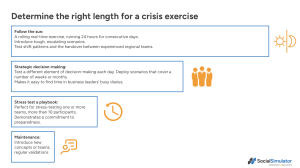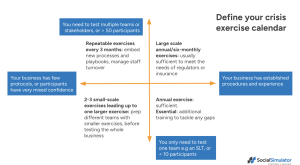Planning a crisis exercise and not sure how long the exercise should last? We've produced a guide to help you consider the options (and pitch your plan to colleagues!). Crisis exercises broadly fall into 4 different time formats:
We deliver examples of three of these every month: half- and full-day exercises, and large scale drills.
Number 3 - shorter sessions on consecutive days - are becoming very popular. This is a great format for very senior teams who need to be tested on their strategic decision-making. Typically it's easier to find an hour a day for 4 days, than ask them to commit to a full- or half-day. These are also great for teams who need to test their abilities across a scenario that might cover a long-term crisis. For example, a product recall that leads to reputational issues and longer-term regulatory intervention. However you design and deliver your exercise, be creative with the format. Meet the demands of the scenario, with those of participants and the logistical challenges you face.
Download our guide: Determine the right length for a crisis exercise

The businesses who are most successful at handling crises are those who exercise regularly. But within any business there are many different teams, and varied levels of confidence and resilience. It isn't always appropriate to put entire organisations through the same annual stress test, nor demand lots of time each quarter from senior leadership.We've produced this grid to help you think through the priority teams you need to develop, and where they - and your organisation - are at, with playbooks and protocols. This will then shape your crisis exercise diary for the year ahead; from testing senior leadership teams, to validating frontline staff. Download the grid, plot your priority training and we'll help you design a crisis exercise program that's practical, achievable and engaging.
Download our guide: How frequently should we deliver crisis exercises
